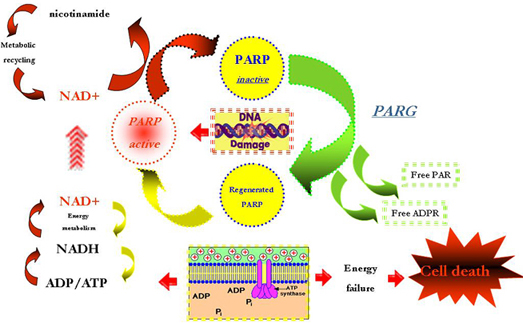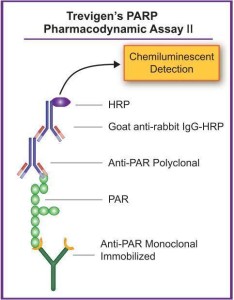PARP (poly ADP-ribose polymerase) is a multifunctional protein post-translational modification enzyme found in most eukaryotic cells. When DNA is damaged, PARP can catalyze the polymerization of poly ADP ribose to itself and neighboring histones in a NAD+-dependent manner, thereby participating in a series of events in DNA base excision repair. When the intracellular NAD+ pool is largely eliminated, it will cause PARP-mediated necrosis induction, in which PARP-1 cleavage promotes apoptosis by preventing DNA repair and blocking the supply of necrotic energy. Experiments have shown that inhibition of PARP can prevent Tissue damage in myocardial and neurological ischemia, diabetes, septicemia, stroke and other diseases, and even contribute to chemotherapy and radiotherapy sensitization in tumor treatment.

PARP is involved in a series of events in DNA base excision repair. Elimination of severe intracellular NAD+ pools will result in PARP-mediated necrosis induction, whereas PARP-1 splicing promotes apoptosis by preventing DNA repair-induced survival and blocking the supply of necrotic energy. In addition, inhibition of PARP can promote tumor chemotherapy and radiotherapy sensitivity. In view of the need for detection of PARP activity in different individuals and cells, Trevigen has innovatively developed a high-throughput PARP in vivo pharmacokinetic II generation kit for detecting PAR levels in tissue and cell extracts and for recording tumor lysis. Differences in PAR levels between fluids and organs.
The Trevigen High-Throughput Universal PARP Assay Kit identifies known or potential PARP inhibitors by detecting the polymerization of biotinylated poly ADP ribose in a 96-well plate to adjacent histones. The kit has developed a 96-well plate pre-coated with PAR monoclonal antibody as a capture antibody, which can capture PAR and PAR binding proteins in cells, incubate with anti-PAR polyclonal rabbit-derived antibody as detection antibody, and label goat with HRP. The anti-rabbit specifically binds to it, and the chemiluminescent HRP substrate produces a detection signal, and its light unit (RLU) reflects the intracellular PAR level.
This kit features:
1. Detection by chemiluminescence method, no radioactivity; 
2. Pre-coated 96-well antibody capture plate;
3. High signal rate;
4, 2 pg / ml PAR detection sensitivity;
5. Linear dynamic range up to 1,000 pg/ml;
6. Reduce the variability between analyses;
7. Reasonably detect the effect of drugs on PARP in the body and in vitro environment.
Trevigen is a fast-growing US biotechnology company focused on oncology research products and services for apoptosis, DNA damage and repair, tumor cell function and behavior. As Trevigen's general agent in China, Amy Jie and Trevigen provide Chinese researchers with the best and most up-to-date quality products and technical services in areas such as oxidative stress, cell damage and tumor cell behavior research. Amy Jie provides you with a one-stop PARP-related experimental solution, in addition to the PARP in vivo pharmacokinetic second-generation assay kit (PDAII), as well as a universal PARP assay kit (containing histone-coated detachable plates) and HT Universal PARP Apoptosis Colorimetric Assay Kit, as well as related antibodies and recombinant proteins. If you are interested in the above products and solutions, please call Aijiejie Technology Co., Ltd. at 400-6800-868 for relevant experimental solutions for angiogenesis research, or request the latest product information. Article source: http://
Corn Starch,Organic Corn Starch,Corn Starch Native,Food Grade Corn Starch
SHANDONG BAISHENG BIOTECHNOLOGY CO., LTD , https://www.baishengbioproducts.com